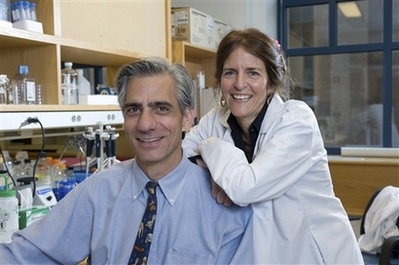Gene therapy improves vision in nearly blind
(Agencies)
Updated: 2008-04-28 07:11
Updated: 2008-04-28 07:11
NEW YORK - Scientists for the first time have used gene therapy to dramatically improve sight in people with a rare form of blindness, a development experts called a major advance for the experimental technique.
 This undated image released by the Children's Hospital of Philadelphia shows doctors Albert Maguire, left, along with wife Jean Bennett at the University of Pennsylvania. The two are part of two teams of scientists in the United States and Britain that are using gene therapy to dramatically improve vision in four patients with an inherited eye disease that causes blindness in children. The results of the experimental treatment were published online Sunday by the New England Journal of Medicine. [Agencies] |
Some vision was restored in four of the six young people who got the treatment, teams of researchers in the United States and Britain reported Sunday. Two of the volunteers who could only see hand motions were able to read a few lines of an eye chart within weeks.
"It's a phenomenal breakthrough," said Stephen Rose, chief research officer of the Foundation Fighting Blindness, which helped pay for one study done at Children's Hospital of Philadelphia.
If successful in larger numbers, experts said, the technique has the potential to reverse blindness from other kinds of inherited eye diseases.
"I think this is incredibly exciting," said Dr. Jean Bennett, a professor of ophthalmology at the University of Pennsylvania and a leader of the Philadelphia study. "It's the beginning of a whole new phase of studies."
The research was published online Sunday by the New England Journal of Medicine in conjunction with presentations at a medical meeting in Florida.
The two teams of scientists, working separately, each tested gene replacement therapy in three patients with a form of a rare hereditary eye disease called Leber's congenital amaurosis. There's no treatment for the disease, which appears early in infancy and causes severe vision loss, especially at night.
An estimated 2,000 Americans have the form of the disease they targeted, Bennett said.
Gene therapy -- replacing faulty genes with a normal version -- has been studied in humans for over 15 years with limited success. The field suffered a setback with the 1999 death of Jesse Gelsinger, 18, in an experiment for a liver disorder at Penn. And some children treated for an immune disorder called the "bubble boy disease" later developed leukemia.
The early results of the eye experiments should give the field a boost, some experts said.
"I think it's really a big shot in the arm for gene therapy and for medicine in general," said Dr. Ronald Crystal, head of genetic medicine at Weill Cornell Medical College in New York.
Each of the study participants had mutations in a gene that makes a protein needed by the retina, which senses light and sends images to the brain. Those without the gene gradually lose sight until they are blind in early adulthood.
The retina itself stays in relatively good shape for a while, making it a good candidate for gene therapy, said Robin Ali, a professor at University College London, who led the British team. He likened the defective gene to a missing spark plug in a car engine.
"The whole engine can be absolutely fine, but if it doesn't have a spark plug, the car's not going to work," said Ali.
For the experiment, the scientists injected millions of copies of a working gene beneath the retina in the back of the eye. Only one eye was treated -- the worst one -- in case anything went wrong; the untreated eye was used for comparison. After the treatment, their eyesight and light sensitivity were measured periodically; mobility was tested in a maze or an obstacle course.
|
||
|
||
|
|
|
|

